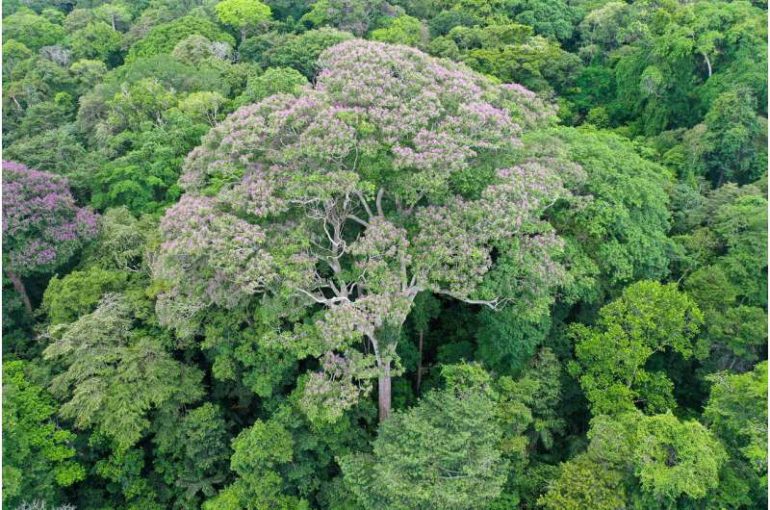Giant trees in tropical forests, witnesses to centuries of civilization, may be trapped in a dangerous feedback loop according to a new report in Nature Plants from researchers at the Smithsonian Tropical Research Institute (STRI) in Panama and the University of Birmingham, U.K. The biggest trees store half of the carbon in mature tropical forests, but they could be at risk of death as a result of climate change—releasing massive amounts of carbon back into the atmosphere.
Evan Gora, STRI Tupper postdoctoral fellow, studies the role of lightning in tropical forests. Adriane Esquivel-Muelbert, lecturer at the University of Birmingham, studies the effects of climate change in the Amazon. The two teamed up to find out what kills big tropical trees. But as they sleuthed through hundreds of papers, they discovered that nearly nothing is known about the biggest trees and how they die because they are extremely rare in field surveys.
“Big trees are hard to measure,” said Esquivel-Muelbert. “They are the pain in a field campaign because we always have to go back with a ladder to climb up to find a place to measure the circumference above the buttresses. It takes a long time. Studies focusing on the reasons trees die don’t have enough information for the biggest trees and often end up excluding them from their analysis.”
“Because we generally lack the data necessary to tell us what kills trees that are above approximately 50 centimeters in diameter, that leaves out half of the forest biomass in most forests,” Gora said.
Only about 1% of trees in mature tropical forests make it to this size. Others wait their turn in the shade below.
The other thing that makes tropical forests so special—high biodiversity—also makes it difficult to study big trees: There are so many different species, and many of them are extremely rare.
“Because only 1-2% of big trees in a forest die every year, researchers need to sample hundreds of individuals of a given species to understand why they are dying,” Gora said. “That may involve looking for trees across a huge area.”
Imagine a study of blood pressure in people who have lived to be 103. One would have to locate and test seniors from cities and towns around the world: a time-consuming, logistically complex and expensive proposition.
A large body of evidence shows that trees are dying faster in tropical forests than ever before. This is affecting the ability of forests to function and in particular, to capture and store carbon dioxide.
“We know the deaths of largest and oldest trees are more consequential than the death of smaller trees,” Gora said. “Big trees may be at particular risk because the factors that kill them appear to be increasing more rapidly than the factors that seem to be important for smaller-tree mortality.”
In large parts of the tropics, climate change is resulting in more severe storms and more frequent and intense droughts. Because big trees tower above the rest, they may be more likely to be hit by lightning, or damaged by wind. Because they have to pull ground water higher than other trees, they are most likely to be affected by drought.
Hoping to better understand what is happening to big trees, Gora and Esquivel-Muelbert identified three glaring knowledge gaps. First, almost nothing is known about disease, insects and other biological causes of death in big trees. Second, because big trees are often left out of analyses, the relationship between cause of death and size is not clear. And, finally, almost all of the detailed studies of big tropical trees are from a few locations like Manaus in Brazil and Barro Colorado Island in Panama.
To understand how big trees die, there is a trade-off between putting effort into measuring large numbers of trees and measuring them often enough to identify the cause of death. Gora and Esquivel-Muelbert agree that a combination of drone technology and satellite views of the forest will help to find out how these big trees die, but this approach will only work if it is combined with intense, standardized, on-the-ground observations, such as those used by the Smithsonian’s international ForestGEO network of study sites.
Esquivel-Muelbert hopes that the impetus for this research will come from a shared appreciation for these mysterious living monuments:
“I think they are fascinating to everyone,” she said. “When you see one of those giants in the forest, they are so big. My colleague and Amazonian researcher, Carolina Levis, says that they are the monuments we have in the Amazon where we don’t have big pyramids or old buildings… That is the feeling, that they have been through so much. They are fascinating, not just in the scientific sense but also in another way. It moves you somehow.”
Lightning strikes more than 100 million times per year in the tropics
More information:
Evan M. Gora et al, Implications of size-dependent tree mortality for tropical forest carbon dynamics, Nature Plants (2021). DOI: 10.1038/s41477-021-00879-0
Provided by
Smithsonian Tropical Research Institute
Citation:
How will the biggest tropical trees respond to climate change? (2021, March 30)
retrieved 30 March 2021
from https://phys.org/news/2021-03-biggest-tropical-trees-climate.html
This document is subject to copyright. Apart from any fair dealing for the purpose of private study or research, no
part may be reproduced without the written permission. The content is provided for information purposes only.



